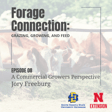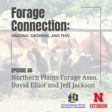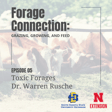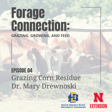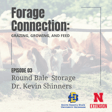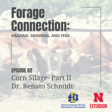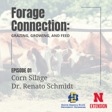Become a Creator today!Start creating today - Share your story with the world!
Start for free
00:00:00
00:00:01

Forage Sampling and Analysis: Rebecca Kern-Lunbery
Rebecca Kern-Lundbery from Ward Labs , talks with us about forage sampling. We chat about how to get an accurate sample, sending your sample to the lab, and how to select an analysis package.
Transcript
Introduction to Rebecca Kern-Lunberry and Ward Laboratories
00:00:05
Speaker
It's The Forge Connection. Grazing, growing, and feed with your hosts, Ben and Sarah.
00:00:11
Speaker
Joining us today is Rebecca Kern-Lunberry. Rebecca is a feed testing product manager and strategist with Ward Laboratories. They're based out of Kearney, Nebraska, and do a lot of work with producers, getting feed tests in, a lot of forage testing. Rebecca, you've worked with us at the University of Nebraska on a number of different projects, and we're really excited to have you on
Impact of Winter on Feed Resources
00:00:34
Speaker
today. Just to talk a little bit, we're in the midst of winter, finally showed up here in the plains.
00:00:41
Speaker
in full force. And we've got producers that are dipping into hay stores, you know, having to pull cattle off of, you know, some grazing resources that they might have been out a little bit longer than normal on, and are at that point of the year where it's really going to be beneficial to know what they have to use. So we're going to try to
00:01:01
Speaker
dive into that topic a little bit today and talk about how we can best go about testing our feed resources and use that information to the benefit of our herd when we go about feeding it. So really excited to have you on today. Thanks, Ben. Thank you for having
Rebecca's Career Journey
00:01:18
Speaker
me. So before we get too far into the details here, Rebecca, can you tell us a little bit more about yourself and your role at Ward Labs?
00:01:28
Speaker
Yeah, definitely. So about myself, so how I kind of ended up here in Kearney, Nebraska. I went to the University of Wyoming and studied animal science and was your classic pre-vet. I want to work with puppies and kitties and kind of learned a little bit more about the beef industry. I had interned at a dairy farm in Minnesota before going off to school.
00:01:57
Speaker
And that kind of got me headed that, you know, I really want to be involved in agriculture and the people around agriculture. And the more I learned about being a vet, the more I learned it wasn't really for me.
00:02:12
Speaker
But being in the lab absolutely was. I did an internship after undergrad at the US Meat Animal Research Center and Clay Center, which then turned into a collaborative project for my master's degree where I studied gene expression in
00:02:31
Speaker
beef cow feed efficiency, steers, excuse me, not cows. And from there, I worked as a technician for a little bit at US Mark. And then I moved over to Ward Laboratories to be a consultant and am currently a professional animal scientist and the president of the NIRS Forage and Feed Testing Consortium.
00:02:58
Speaker
I'd say you've got some experience. So we're going to go ahead and say you're qualified for this esteemed podcast. So Rebecca, it sounds like you really enjoy what you do working in the lab.
00:03:14
Speaker
and you're pretty involved in the industry. So that was one of the reasons that
Importance of Forage Sampling
00:03:18
Speaker
we brought you on today. We thought you'd be a great resource. I know we've met in the past at previous meetings and it's been fun to listen to you. So as we kind of dive in here today, we thought we'd start with the topic of sampling. Before we talk about any analysis or what to do when you get your analysis back, you want to make sure you take the right sample. So why is proper sampling important when it comes to forage analysis?
00:03:44
Speaker
Yep, exactly. Sarah, you always need to start with a good sample. And one of the big sayings in a lot of labs, no matter what kind of testing you're doing, as you know, Ward Labs started as a soil testing lab. And one of Nick Ward, our president's favorite sayings is garbage in, garbage out. So you need to start with a good representative sample. And it's especially key in forages because forages are variable. They consist of leaves and stems and
00:04:12
Speaker
Maybe there's buds, depending what kind of forage we're talking about. They might be mixed species forages, which just adds on to more of those variable aspects, the amount of weed content, the weather, the fertilizing protocol, when that hay was cut, if it was ensiled, what moisture was ensiled at. There's just so many different variables. And so in order to get a good idea of what your entire pile is,
00:04:39
Speaker
on average, which is what you want to do for your animal diet, you really need to make sure that you're getting a good proper sample that's representative of that haystack, silage pile, grazing field, whichever kind of forage you're testing.
00:04:56
Speaker
You want the bag that goes into the lab to represent that because there's so much variability that if you just go in and do one or two haycores and call it a day, you're not going to get that representation that you need because you might be over or under representing different aspects of that forage.
00:05:15
Speaker
As we kind of talk about this, you mentioned there's a number of different forages that producers might come into contact with. And those sampling techniques are going to be a little bit different depending on what we're trying to send into the lab. So maybe we can kind of take it a little bit at a time and focus on one forage type at a time and go through it here. And if we miss any, Sarah and Rebecca.
00:05:40
Speaker
let me know if we've left
Techniques for Sampling Hay
00:05:42
Speaker
one out. But the first one on my list was, you know, hey, whether that's grass hay, alfalfa hay, you know, as long as it's dried, I guess, does it matter when we're talking about it from a sample standpoint, if it's in a bale or if it's loose, if it's in a stack, maybe that's the first question we can answer there. Does that matter? Or if it's in the windrow.
00:06:05
Speaker
Yep, absolutely. So that does matter. So Winrow, Haystacks, those are difficult to sample. We don't really have a well-defined way to sample them. The best thing we can say is make sure you're taking samples from different areas of the stack or
00:06:21
Speaker
Different locations in the windrow where that becomes a challenge is with windrow is typically going to be a hand grab sample So you're going to be losing leafy material through your fingers and so that's really you're typically going to see a lower protein value if you're sampling at your windrow stage versus in your bale and
00:06:43
Speaker
because you've lost some of that protein from the leaf and then you're going to see increased fibers which is going to underestimate the amount of energy that's available. So we really would recommend waiting to sample to get a good representative sample until you're in the bale and then making sure you're sampling that properly. With hay, the first thing you need to do is define your lot and a lot of hay is going to be a single cutting from a single field
00:07:12
Speaker
cut at a specific time of the day with a specific variety. So you don't want to be mixing fields or mixing the timing that it was cut at or mixing, you know, if you had to stop for a day or something for whatever reason. And then it needs to be less than 200 tons. If it's more than that, you need to split it into two, like an A and a B or something like that, north or south of the field, something.
00:07:39
Speaker
And then you want to take 20 hay cores. And you mentioned round bales versus square bales. And so that's kind of difficult to explain on a podcast of where to exactly take your cores. You need to take 20 for each lot. But those cores need to go in about 12 inches into the bale. And the location on a rounded bale, you want it on the rounded side so that you're going through
Using Hay Probes Effectively
00:08:06
Speaker
different layers of hay.
00:08:08
Speaker
So hopefully that kind of makes sense. And then on your squares, you just want to make sure you're going through the layers again. So typically on those square bales, you're going into the shorter side, but through to the longer side. Into the butt end, as they would say. And you know, one thing, Rebecca, that at least around here I've seen, if people have all sorts of different types of probes,
00:08:36
Speaker
So if you don't have a hay probe, a lot of times, I know in South Dakota, you can check them out at the extension offices, and that may be true in Nebraska and other neighboring states as well. Or a lot of feed, animal supply stores have a nutritionist, and sometimes they'll offer that service if you're already a customer to take that sample for you. Absolutely. The question did come up.
00:09:03
Speaker
about what's the best specs basically for a hay probe and the producers I work with are a lot of beef producers and small ruminant producers and with them it's kind of you know always a progression right so the dairymen they know and they they want specific specs on their hay probes because they want the best possible result and with the beef guys and the small ruminant guys
00:09:29
Speaker
just getting them to sample to start and then to not do a hand grab and so like I was working with a small room knit producer in California and he was very far away from the extension office. He didn't have good resources from his vet and so what he ended up doing actually was just cutting off an old golf club that he had that he was able to pound in and so something's better than nothing. A hay probe is better than no hay probe and of course there's different
00:09:59
Speaker
aspects of hay probes that you prefer over others, but for our country, for where we're at with our producers, that is, um, that's what I recommend is just whatever you can find. Wardbabs also has some that you can borrow, but I always tell people, like you said, start with your vet, extension, nutritionist. They are typically going to have it. I guess to summarize that we're, we're trying to get as many layers in that sample as possible for that probe to go through.
Silage Sampling Recommendations
00:10:29
Speaker
basically to even out the variation. If we just went into one layer, we might hit a weedy patch or we might hit a wet spot in the field or something, and that might really throw off our sample. So by getting more layers going in that rounded side or the short side of a square bale, it just helps smooth out that variation and give us a better representative sample that we can actually trust the results on and then go ahead and use.
00:10:58
Speaker
Yep, absolutely. Yes. Yep. So once we've probed our hay, let's say we're a dairy producer, we've got a pretty big heap of silage out there to take care of. So for anybody that is raising silage, once it's fermented, usually you want to do some testing to know what you have there. Where should we begin thinking about that? What type of methods do you suggest?
00:11:29
Speaker
Silage is tricky. So if it's in a bunk, obviously you can't really access very many different areas of it. I honestly recommend to go ahead and sample it when it's being green chopped off the truck and just take a few, mix them in like a clean five gallon bucket and send that to the lab.
00:11:52
Speaker
That's maybe not completely an industry standard, especially not for dairies. Most dairies, I'd say they're kind of sampling as they're going into it. I think getting a sample while you're chopping is going to give you your best average representation, but a lot of the dairies and then like the beef feedlots
00:12:13
Speaker
They're going to be sampling that as it comes off the face from different areas. And then that gets into silage safety and always just being safe when you are working around a silage pile. And then if you are working with a bag, some producers will go ahead and use a hay probe and just probe into that bag. But just know that when you do that, you are always introducing the risk of mold because you're puncturing the barrier that's keeping oxygen out. So if you have fully ensiled,
00:12:44
Speaker
and you're at a good pH, then it's nice and acidic environment. You don't have much to worry about. But if you're sampling too early and it hasn't fermented and it's not well preserved, then that's where you're going to start to see mold spots as you start working through that pile because of where you sampled. So silage is kind of less well-defined and
00:13:11
Speaker
more of a difficult thing but at the same time if you're doing a good job with the chopper and packing and all of that stuff and being consistent across the field it's a little bit less variable I'd say than your hay that you're putting up from year to year. Would that be a situation where
00:13:31
Speaker
If we're taking off a certain amount from that face as we're feeding out and we're pulling that away and throwing it into the mixer or making a secondary pile or to load up, I guess, do we need a sample right off the face? Or if we are removing that, just stopping the loader when we do that, running out and grabbing a couple of samples and
00:13:56
Speaker
Like you said, you know, grab some, throw it into a five gallon bucket, mix it up really good. You know, a couple of different times. Is that representative enough, I guess, or do we need to really doing it from the face? I think either of those would work. I think that doing it probably from what's already been pulled off
Silage Safety Resources
00:14:14
Speaker
the face is going to be safer.
00:14:16
Speaker
And we don't want to have any issues just pulling a silage sample, right? When you're pulling a sample, never a hand grab. So always use a cup or a tool or something like that so that you're not losing those fine particles, because that's always going to underestimate. OK. And if someone's interested, if you're a producer who has employees, the Bolson Silage Safety Foundation is a really great resource online.
00:14:44
Speaker
and they have handbooks and things you can get a hold of, especially if you have a lot of employees and they offer materials in Spanish and English. But yeah, I'm glad you mentioned that because that is a really good resource. Absolutely. Yes. So one more thing I might throw in there. I know on some of our publications from the university, they talk about the quartering method.
00:15:07
Speaker
Mm hmm. And that's just I guess for those that aren't familiar with it, it's a way to take a large pile, narrow it down to the amount because you only need when we're submitting a sample into the lab. Well, like a quart size bag, is that? Yeah, that's all we need a quart size bag.
00:15:25
Speaker
And we really don't want much more than that, because then that causes us to have to split things and try to make sure that we're representing what was sent, submitted to us, which we always do. But it's better if that's kind of done on your end. You don't want us showing up with a trash bag full of silage. No, but it does happen, and we do handle it. So it's not something that we'll ever scoff at or turn you away. But if we can help you out,
00:15:55
Speaker
It's definitely worth doing and maybe, no. Unfortunately not. That would be great if you could just jump the line because your sample's ready to go in the oven or whatnot. But everything gets batched. So it doesn't matter as long as if it came in on that day, it's running with everything on that day. And actually silages usually are what's taking forever in the ovens. So sometimes silages actually are kind of a hold up on some stuff. Just because they take longer to dry.
00:16:25
Speaker
just with the moisture content. So I guess when we're talking, if you do hear that term, the quartering method, that's taking that pile, splitting it into quarters, taking a subsection, it's a nice way to do it, to get a representative sample. If I've got my five gallon bucket and I'm taking several subsamples like you recommended with a cup to, you know,
00:16:52
Speaker
make sure that I'm getting everything in there, mix that up really good and take a few scoops out of the cup to fill up my bag. Do I need to take the time? I know technically we should do the quartering method. Yeah, but I would recommend the quartering method. I'll just use the bucket as a good way to collect your sub samples because you're going to collect more than you submit, like you said, and then dump it out on a big piece of newspaper or something like that.
Quartering Method for Forage Sampling
00:17:22
Speaker
We use butcher paper at the lab. And actually, once, once you kind of get it down, it's pretty easy. And it goes pretty fast. So and so the for those that aren't familiar, we we dump it out, we split it into force. Get rid of kind of take the two corner pieces, get rid of the rest, mix it again. Yep.
00:17:46
Speaker
Mix it, use the corners of your paper to roll, to kind of pull it and turn it until it starts to form a cone shape. And that's why it's a cone and quarter method. So once it gets that cone shape, then quarter it and basically do that until you can get just a quart size Ziploc bag. And then I always recommend whether it's a hay sample. I mean hay samples, we typically don't recommend splitting.
00:18:12
Speaker
But if you can keep a subset, that always is nice in case you ever have any questions and you don't have to go redo the whole thing. Anything else on silage? So I guess the only other thing I'd say, you know, we talked about variability being the reason why we're sampling. So with corn silage, remember, it's very variable and it's almost more like a mixed feed. So it's going to be something that you are going to have to try to do a very good job of
00:18:42
Speaker
getting that representative sample of the amount of corn kernels and all of that kind of stuff. And then with that, I know we're not talking test packages yet, but I always recommend to run pH. I'm still kind of convincing some people. Most people don't run it until they have a problem. But that's a really good way to know if your ensiling went well and to be able to make adjustments for next year if it didn't.
00:19:13
Speaker
A lot of sense. And I think, yeah, we'll definitely dive further into analysis here. So before someone gets those samples to you, they've got to get them ready and ship them most likely, unless they're real close to the word location. So what are some good ways, methods that you would like to see people ship their forage samples, whether it's hot out, cold out, somewhere in between?
00:19:38
Speaker
So this answer kind of surprises people and our lab may be different than other labs in this aspect too, but dried hay and silage, they both should be pretty well cured to where
00:19:50
Speaker
It doesn't matter. We recommend you put them in a sealed Ziploc bag so that the moisture is preserved and correct when it comes to the lab. But those two things are pretty well unaffected because they're spending a few days in the mail and then once they get here, they go in the oven as soon as they get here. So if you think your sample is going to spoil in that short amount of time,
00:20:13
Speaker
If it's a hay, you probably didn't do a good job getting it down to the right dry matter. If it's a silage, you probably didn't do a good job in siling it. So if you've got those two.
00:20:23
Speaker
That's good. The only time cold weather obviously is less of a concern. If you do freeze your sample, then all that means is that we have to actually sit and wait for it to thaw before we can run it. And I also wouldn't recommend running NIR analysis on frozen samples because the cell walls burst and that may affect how that is viewed through that NIR system.
Shipping Forage Samples to Labs
00:20:50
Speaker
And then for fresh samples in the middle of summer that are really moist, they're not ensiled, I just recommend just put them in the mail right away. It's very rare that we get a sample that's got mold issues. If it has mold issues, it's because it usually got lost in the mail for like a month. But otherwise, if it's just sent, spent a couple of days in the mail, it's usually just fine. So that's kind of what we recommend.
00:21:20
Speaker
If you do have concerns on those fresh pasture forages in the summer, you can always pay to have them overnighted. That would be the best solution for that. How about those cured samples? If you're mailing them off this time of year, if you're opening a pile with concern, I mean, should people consider more of an insulated package so they don't freeze?
00:21:45
Speaker
Um, no, we're not, we don't usually get packages that freeze because of the weather. It's because someone's frozen them to send them because other labs do say that you should do that. Um, we just don't. Makes sense. So any kind of specific packaging or you kind of mentioned the size of sample earlier, you don't need a garbage bag full. Um, do you like to see a certain type of package and is there a time of the week to avoid shipping or does it matter too much?
00:22:16
Speaker
I mean, always, if you're putting your sample in the mail on Friday, it's going to sit in there a couple of extra days. So if you want it to get there quickest, it's going to obviously be better, you know, earlier in the week. We ask for a court-size Ziploc bag. We do provide those. Right now, we do charge shipping to ship those sample
00:22:41
Speaker
supplies out to people and we do provide a postage paid mailer so sending the sample back to us you don't pay anything so if you can stop by the lab and pick those up or if you see us at a trade show or an event then that's probably the easiest way that people do it. A lot of people don't know you can tape those to a box and then that box you know keeps everything together and we still pay the postage on it
00:23:06
Speaker
But even if you don't have our mailers, you can always just send them to us. I always say keep all your samples together in a box.
00:23:14
Speaker
And that way nothing gets split up because we get a lot of customers who are like, well, I got three samples back, but I still am waiting on results for one or two. And sometimes we haven't received them because they've just been sitting in the mail somewhere. So as far as packaging, I'd say that's about it. The only other thing is I'd say there's one test, which is prussic acid, which I typically avoid talking about.
00:23:40
Speaker
But since you did ask about timing of mailing, we will only run that if it's been overnighted to us and has arrived Monday through Thursday. We do not run it on Fridays and we do not run it if it's been sitting in the mail for too many days because it's a gas and it releases over time. So we want our result if it says safe to actually be safe and not to be potentially toxic. Definitely makes sense for sure.
00:24:10
Speaker
So once we are ready to get this in the mail to you, how do we choose an analysis package? How do we go about determining what information we need to give you to get results?
Forage Testing Packages
00:24:26
Speaker
So for all forages we offer NIR analysis and we use NIRS forage and feed testing consortium calibrations.
00:24:37
Speaker
So the NIS Forage and Feed Testing Consortium for people that maybe don't know is a group of commercial labs such as ourselves, researchers, instrument vendors, government entities, the alfalfa seed breeders, they're in there too. So basically every stakeholder in the field is submitting samples from all across the country. So they are the most robust
00:25:06
Speaker
calibrations out there to suit any kind of sample. So that's what I recommend to start with. And then they're going to include the main things that most producers are going to want to know, which is going to be, you know, your crude protein, your fibers, your calculated values such as TDN, RFV, RFQ. If you're an equine person, they're going to include the items you need to know for your equine diabetes.
00:25:30
Speaker
So that's kind of the base package I recommend to work off of. And then if you're looking at doing a mineral supplement, I recommend wet chemistry mineral analysis. If your forage is a nitrate accumulator like oats, hay, sorghum, sedan, anything like that, then you have to add nitrates. That's not included in those packages. And pH, like I mentioned before, with the silage.
00:25:58
Speaker
Those would be kind of the typical additions that I recommend. And are all of those packages information we can get online or do people receive that in the mail so that they can send it in with their samples? Yes, so you can get it online. You can go in, you can print out our submission form, you can see all the information about the packages on our website.
00:26:23
Speaker
Right now, I do think our website needs a little bit of updating because we've had a few things change in the past couple of months. We are no longer offering four minerals with the NIR, but I think it says that we still are. So that's kind of something to be aware of. Otherwise, they can always email me and I can send them the information. They can email our customer service or one of our sales reps too, and they can send them that information. We can mail in that information as well.
00:26:53
Speaker
And I think that information is true if someone's listening in, but they're in a different part of the country or they use a different lab. I think that is true across the board for most labs. Yes, yep.
NIR vs. Wet Chemistry Analysis
00:27:06
Speaker
So when we're talking NIR, you know, that's not maybe as newfangled anymore as it used to be, but versus, you know, a lot of folks might have
00:27:18
Speaker
been more familiar with the traditional wet chemistry, when do we choose one over the other? I know NIR is a lot more competitive when you look at it from a cost standpoint, but are there circumstances where we might still want wet chemistry? You mentioned the mineral packages, but even just for the general analysis. Yeah.
00:27:45
Speaker
It's going to be, if you're sampling something that's going to be pretty common, that's going to be some, you know, prairie hay or, you know, something that's a common feed type, you should run NIR. It's going to be fine. If it's something that's odd, for example, we had a researcher send in some sunhemp samples recently. They wanted to do NIR because they wanted all the constituents.
00:28:12
Speaker
but their samples were not a good fit for our calibrations because we have a few samples like that because I know I've submitted them to the consortium, but we don't have a lot of sunhemp in the database. It's not a good fit. If you have something like a common one that a lot of people do is they'll bail up just a big weedy patch,
00:28:36
Speaker
um that's not going to be a good fit for nir either so really anything that's an oddball um or i know ben you and i have emailed i think back and forth a little bit about heat damage
00:28:49
Speaker
Um, heat damage protein is included in the NIR package. However, that's for, you know, kind of stuff that's like on the fence, not sure. If you've got some real heat damage where it's turned the forage color and it's got that classic tobacco smell, we would recommend that be ran wet chemistry. Um, so some of it's a judgment call. Um, any cover crop mix, I'd say that has brassicas in it.
00:29:16
Speaker
brassicas scan weird for whatever reason and I and you could ask reach out to the NIR consortium Bobby Joe Anderson Houston she would know more about that than I do I just take her word for it you know but they don't scan right so we don't want to be putting those on so yeah kind of anything that's a bit of an oddball
00:29:40
Speaker
is going to be better to run wet chemistry and if you ever are hesitant or unsure you can always just call us and ask and we'll tell you a direct answer. Because basically with that NIR you're running a laser reading the light spectrometry that comes off of that and then comparing it to your database of wet chemistry already done wet chemistry
00:30:06
Speaker
Yes. Yep. If you don't have that wet chemistry to compare it to, or it's not reading accurately, then it doesn't. Yep, exactly. And our lab looks at a global age, which is a statistic that'll tell us, hey, this sample is not a good fit. So sometimes, even samples that should run well under our calibrations, our flag does not
00:30:30
Speaker
basically being outliers. So we always run wet chemistry, crude protein, ADF and NDF, which we think are kind of the main things most people are going to be after at no charge when that happens. So. Okay. So Rebecca, is there anything else that we haven't covered that you would want to cover?
Deciphering Forage Analysis Reports
00:30:52
Speaker
Really, what I just wanted to say is just that sampling doesn't do any good unless we understand our reports. So you can go through and get a great sample. But if you're not doing something with those numbers, then it's kind of pointless. So our lab puts out a lot of educational resources about that. I know both South Dakota and UNL have a lot of great resources for helping interpret forage reports.
00:31:21
Speaker
But really every interpretation is dependent on your situation, what animals you're feeding, how far you have to stretch it, what other feeds you have to complement your forages, how you can use it. And so I always just encourage people to reach out to their resources, whether that be their vet, their extension agent, if they're able to, you know, work with a nutritionist to really make sure they're getting the most out of their forages.
00:31:52
Speaker
Absolutely. And that's so true of so many things we talk about in extension or on this podcast that if you don't put the effort in and even if you do at the front end, but you don't actually look at the results at the back end, it's just kind of a waste of time. So hopefully folks that are maybe newer to sampling some of their forages are willing to reach out and do a little reading on the results because sometimes I think it's overwhelming with
00:32:22
Speaker
plants and soils anything really any lab results can come back and you're like, so do I do with this? No, I say especially being a producer where they have, you know, this is what we specialize in understanding these things and they have to know so many different things. So yeah, so don't be afraid to reach out to the Extension Office closest to you or the lab that you had your sample sent to for a little bit of extra information.
Contact Information and Local Resources
00:32:50
Speaker
Rebecca, you mentioned a couple of times, you know, if folks have questions or things, um, to get ahold of you or, or ward labs there, what's the best way to do that? So we are currently under a limb system change and normal, my normal availability is much more limited than it used to be. So I would say reach out to your extension agents. But if you do need some consultation from the lab,
00:33:19
Speaker
I will be most responsive over email and you can always call and leave a voicemail and I am to the point where I can finally start getting back to people but it's going to be like within 24 to 48 hours business day wise. Hopefully once our system gets a little smoother, my time will free up and I will be mostly being consulting and you guys can call me and I will answer and be Johnny on the spot like I used to be.
00:33:50
Speaker
Our phone number is 308-234-2418. And then my email is rkern at wardlab.com. All right. So if you have an emergency, maybe don't contact you right now. But if you've got a general question or something, as long as you're willing to wait a little bit.
00:34:15
Speaker
especially if it's dealing with wet chem, NIR, or some of those things that we talked about, feel free to reach out. Yes, definitely. Don't want to discourage anyone from reaching out and hopefully in the coming months, it'll be back to normal. But if you are one of our usual customers and you've been hanging on with us, we do appreciate that right now.
00:34:40
Speaker
The lab work has not changed, I will say that. Our lab work is still very accurate and reliable. Well, Rebecca, we really appreciate you taking some time to talk with us today.
00:34:53
Speaker
You know, we hope that everyone listening took a little bit away, why it's important, how we can get a really good sample. You know, maybe sometime down the road, we can dive into what those analysis actually look like, maybe get you back on and talk about the actual analysis side of it.
00:35:11
Speaker
I think just at this point of the year, making sure that we get those good samples, how we send those in, and why it's important to get those good samples was a good discussion to have. So thanks for coming on again, Rebecca. And all of our listeners, thank you for joining us today on the Forage Connection.
